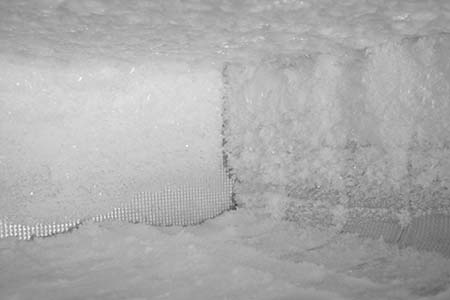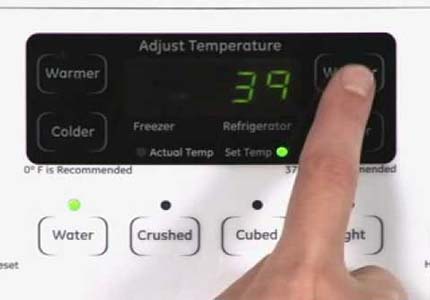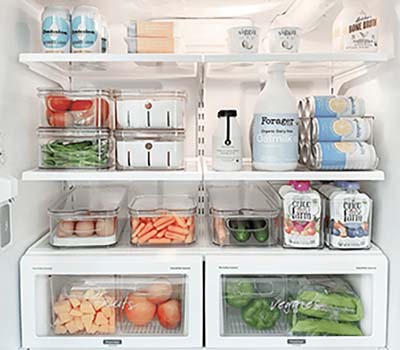Your refrigerator is a crucial appliance in your kitchen, responsible for preserving your food and ensuring it remains fresh and safe to consume. However, there are instances when your fridge can become a bit too efficient, causing over-freezing. Over-freezing can lead to various issues, including compromised food quality and the need for costly repairs. In this comprehensive guide, we’ll delve into the causes of over-freezing in your fridge and provide practical solutions to address this issue effectively.

Understanding Over-Freezing in Your Fridge
The Importance of Addressing the Issue
Causes:
- Inaccurate Temperature Settings: One common cause of over-freezing is incorrect temperature settings. If the temperature is set too low, your fridge can start behaving like a freezer.
- Lack of Temperature Monitoring: Neglecting to regularly monitor and adjust your fridge’s temperature settings can contribute to over-freezing.
Solutions:
- Regular Temperature Checks: Make it a habit to monitor your fridge and freezer temperatures using a thermometer to ensure they are within the recommended ranges.
- Adjusting Temperature Settings: Familiarize yourself with the ideal temperature settings for your fridge and freezer and adjust them accordingly to prevent over-freezing.
Common Causes of Fridge Over-Freezing

Causes:
- Inaccurate Temperature Controls: Over-freezing can occur when temperature control mechanisms, such as thermostats, malfunction.
- Poor Airflow: Inadequate air circulation inside your fridge can cause cold spots and uneven cooling, leading to over-freezing in certain areas.
Solutions:
- Check Temperature Controls: Regularly verify that the temperature settings for your fridge and freezer are appropriate and not set too low to avoid over-freezing.
- Inspect Door Seals: Regularly examine the door seals for any damage or wear and replace them if necessary to maintain proper sealing and prevent over-freezing.
Overview of Frequent Culprits
Identifying the Root of the Problem
Solutions:
- Regular Inspection: Perform routine checks of your fridge for signs of over-freezing, such as frozen food items or icy build-up.
DIY Troubleshooting Steps
Solutions:
- Temperature Adjustments: If you notice over-freezing issues, fine-tune the temperature settings to strike a balance between food preservation and preventing over-freezing.
Step-by-Step Guide to Diagnosing Over-Freezing Issues
DIY Solutions for Common Over-Freezing Problems
Causes:
- Temperature Control Issues: Malfunctioning temperature control mechanisms can result in over-cooling.
- Inefficient Airflow: Poorly organized shelves and blocked vents can disrupt proper airflow.
Solutions:

- Temperature Adjustments: Fine-tune the temperature settings to strike a balance between food preservation and preventing over-freezing.
- Organize Your Fridge: Arrange food items strategically, so air circulates evenly, reducing temperature fluctuations.
How Temperature Control Impacts Food Preservation
Adjusting Your Fridge’s Temperature Settings
Solutions:
- Proper Temperature Settings: Ensure that your fridge and freezer are set to the recommended temperatures to prevent over-freezing.
Improving Airflow and Organization
Causes:
- Inadequate Airflow: Poorly organized shelves and overcrowded compartments can obstruct proper airflow, leading to over-freezing in some areas.
Solutions:
- Organize Your Fridge: Properly arrange food items to allow for better air circulation and even cooling.
Ensuring Proper Air Circulation to Prevent Over-Freezing
Organizing Your Fridge for Optimal Temperature Distribution
Solutions:
- Categorize Food Items: Group similar food items together and utilize designated fridge zones to maintain proper temperature distribution.
Understanding the Function of Key Refrigerator Parts
Cleaning and Maintaining Critical Components

Causes:
- Dirt Buildup: Accumulation of dust and debris on components like the condenser coils and evaporator fan can impair their function.
- Neglected Maintenance: Failing to perform regular maintenance can result in critical component issues.
Solutions:
- Regular Cleaning: Routinely clean components like the condenser coils, evaporator fan, and vents to ensure optimal airflow and temperature control.
- Scheduled Maintenance: Consider scheduling professional maintenance at least once a year to inspect and service critical components.
Checking Seals and Gaskets
Causes:
- Worn or Damaged Seals: Seals and gaskets that are worn, torn, or damaged can allow excess cold air to seep in.
Solutions:
- Visual Inspection: Regularly examine door seals and gaskets for any visible damage, including cracks or tears.
How Food Placement Affects Temperature Distribution
Effective Food Storage Tips to Prevent Over-Freezing
Solutions:
- Rotate Stock: Implement the “first in, first out” principle to ensure older items are used before newer ones, preventing over-freezing.
- Use Air-Tight Containers: Store foods in airtight containers to prevent moisture loss and freezer burn.
Preventive Measures
Solutions:
- Regular Servicing: Schedule regular maintenance checks with a professional technician to address any potential issues before they become major problems.
- Educate Yourself: Learn about your fridge’s maintenance requirements and perform routine tasks like cleaning coils and checking seals.
Best Practices to Avoid Future Over-Freezing Incidents
Implementing Regular Maintenance Routines for a Reliable Fridge
Solutions:
- Scheduled Maintenance: Create a maintenance schedule to ensure your fridge is serviced regularly, preventing over-freezing issues in the future.
By understanding the causes of over-freezing in your fridge and implementing the provided solutions, you can effectively prevent this issue, maintain the quality of your food, and ensure your fridge operates efficiently. Enjoy well-preserved food in your fridge and avoid the hassles of over-freezing with these practical steps.